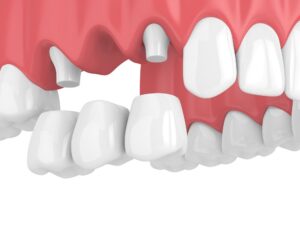Have you lost several teeth in a row? Missing teeth can majorly disrupt your life, but your dentist can offer highly effective treatments to replace these teeth and restore your oral health. A dentist can replace one or more missing teeth using a traditional dental bridge.
Though a bridge offers many advantages, your dentist will want to evaluate your unique dental scenario to ensure this appliance is the best way to fully restore your smile. Read on to learn more about a traditional dental bridge, including the procedure and the benefits you can expect.

How Does the Dental Bridge Treatment Work?
The traditional dental bridge is a fixed oral appliance, meaning you cannot remove this device once a dentist secures it into the mouth. You can feel confident in the fit of your bridge while still choosing an affordable tooth replacement solution.
The traditional bridge stays in place by using surrounding teeth as abutments. This means that the device features dental crowns on each end that will fit over these abutment teeth, sealing into place with dental cement. The crowns appear seamlessly with the prosthetic teeth between them for a gorgeous and natural-looking finish.
The dentist must prepare the abutment teeth before placing the bridge, which entails removing a minute amount of enamel to make room for the caps that snap over the teeth. You will receive a local anesthetic to ensure you do not feel discomfort during this process.
How Long Will a Traditional Bridge Last?
With proper care and maintenance, you can enjoy restorative benefits from your traditional dental bridge for ten years or more. Though the durable ceramic material and cement ensure a secure fit, a dental bridge is not indestructible. You should avoid biting down on hard items if you want to preserve your new oral appliance.
Abnormally high pressures on your bridge might cause it to break or dislodge. In the event of this accident, call your dentist as soon as you can. A damaged traditional bridge can mean that the underlying abutment teeth are exposed and at risk of dental dangers.
Practice good oral hygiene to make sure you keep your mouth healthy and stable. If you get gum disease or cavities, your mouth may alter, which could disrupt the fit and function of your dental bridge.
Visit your dentist on a regular basis too to maximize preventative dental care. During these appointments, they will also check that your bridge fits and works as it should.
Traditional dental bridges offer effective restorative advantages, but to get the most comprehensive tooth replacement, your dentist might suggest an implant-supported bridge instead. This uses surgically placed anchors in the jaw to support prosthetic teeth and replace missing tooth roots too.
Dental implants can last twenty or more years, significantly longer than a traditional bridge. Schedule a consultation with your dentist to find the tooth replacement solution that will best suit your unique dental needs.

